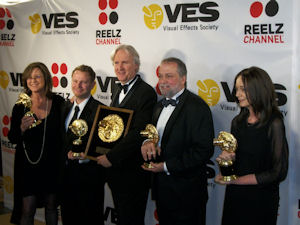The membership of the Visual Effects Society twice honored director James Cameron at its 8th annual awards show on Feb. 28 in Century City. First were the six statuettes given to “Avatar,” Cameron’s sci-fi 3D mega-blockbuster grossing more than $2 billion in worldwide box office receipts The second was in receiving the Encino-based society’s Lifetime Achievement Award for a body of work that has pushed the creative envelope in film effects, from the computer generated images in “The Abyss” and “Terminator Two: Judgment Day” to the 3D world of Pandora in “Avatar.” While technological advances are replacing the effects used when he started his filmmaking career, Cameron placed a greater importance on the human element behind what he called ultimate magic. “It’s the artist, the imagination and a sense of pioneering spirit that make visual effects work,” Cameron said backstage. “Computers don’t make visual effects; imagination does that.” Society members around the world choose the award winners for their work in feature films, television, commercials and video games. For the second year, the VES paired with Autodesk to present a student award. Ed Catmull, a co-founder of Pixar Animation Studios, received the Georges Melies Award for Pioneering for his groundbreaking work in computer graphics. Catmull helped set up three of the leading centers of in computer graphic research and at Pixar (now owned by Disney) oversaw 10 feature films, including that night’s nominee, “Up,” said presenter and visual effects artist Jim Morris. “Under Ed’s watch each film has been a technical, artistic and financial success,” Morris said. “Up” was the second big winner of the night coming away with three awards: Outstanding Animation in an Animated Feature Motion Picture; Outstanding Effects Animation in an Animated Feature Motion Picture; and Outstanding Animated Character in an Animated Feature Motion Picture. From the first award presentation for use of models and miniatures in a feature film it was apparent that “Avatar” would dominate the proceedings. The film had three nominations in one category – Outstanding Created Environment in a Feature Motion Picture – and ended the night with members of the effects team accepting the award for outstanding visual effects in a visual effects driven movie, considered to be the VES’s version of the Best Visual Effects category for the Oscars. Only “District 9″ stood in the way of “Avatar” sweeping all of its nomination. The sci-fi thriller won the outstanding compositing award, a category in which “Avatar” had two nominations. That minor glitch did not take away from Cameron’s night as the filmmaker was honored with a retrospective and testimonials from actors Bill Paxton – featured in four Cameron films – and Tom Arnold, who starred alongside Arnold Schwarzenegger in “True Lies.” Although not having been directly involved with producing visual effects for many years, Cameron numbered himself among the effects artists gathered that evening. Growing up he took inspiration from the work of Ray Harryhausen in “Jason and the Argonauts” and “Mysterious Island” and later Stanley Kubrick’s breakthroughs in “2001: A Space Odyssey.” “When ‘Star Wars’ came along, again with stunning imagery, at that point I took action,” Cameron said. “I quit my job and I started doing film.” “Avatar” has multiple nominations in this year’s Academy Awards being presented March 7 at the Kodak Theatre in Hollywood. Backstage at the VES Awards, Cameron said his film had a good chance to win for best visual effects. “Avatar” is one of 10 nominees for Best Picture, in competition with Iraq war drama “The Hurt Locker,” directed by Kathryn Bigelow, Cameron’s ex-wife. “If (the winner) is ‘Hurt Locker’ or ‘Avatar’ I’ll be happy,” Cameron said.
